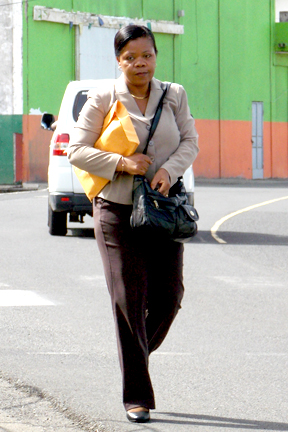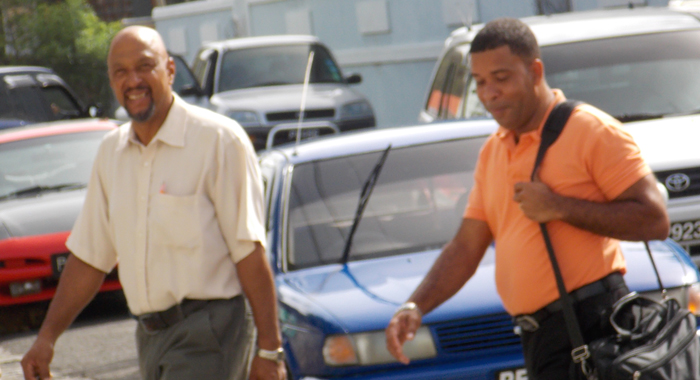
A coroner’s inquest this week returned a verdict of death by misadventure in the 2006 disappearance of an SVG Air twin-engine Aero Commander 500S aircraft with two persons onboard.
And while Director of Airports Corsel Robertson told the inquest that the occupants of the aircraft, the pilot, Dominic Gonsalves, and passenger, Rasheed Ibrahim, died, she also said that proper procedure was not followed in the aftermath of the disappearance of the aircraft.
The aircraft or its occupants were never recovered.
The plane, J8VAX, was travelling from the Grenadine island of Canouan to St Vincent on Nov. 19, 2006.
The coroner’s inquest on Tuesday at Calliaqua Magistrate Court was held to establish how, where and when the plane’s occupants died.
The inquest heard that the plane left Canouan at 6:42 p.m. on Nov. 19, 2006 and was scheduled to land at 6.54 p.m. that same day at E.T. Joshua Airport at Arnos Vale.
Air traffic controller Malaika Jones logged the aircraft as having landed as scheduled, but when checks were made, it was discovered that the plane never landed.
Nicha Branker, Ibrahim’s mother, raised the alarm after waiting fruitlessly outside the airport for her son.
According to earlier reports, the search for the missing aircraft started around 9:30 p.m. and fishermen found items from the aircraft about two-miles northwest of Bequia, which is located nine miles southeast of the E.T. Joshua Airport.
The items comprised an unused flare kit, an uninflated lifejacket, a wheel chock with the marking “SVG Air”, a seat rest and a seat.
Robertson told the inquest that the duty of air traffic controllers is to monitor flights and provide an alert service in cases where aircraft are in distress, or where the communication has been lost.
She also said the service requires that Coast Guard and police be notified early, in the event there is need for search and rescue operations.
In the case of the disappearance of the plane proper procedure was not followed, she said.
Robertson said that air traffic controller James Ollivierre did indicate to her that there was an arrival time logged but when checks were made for the plane on the ground it was not there.
Robertson said she was on vacation leave at the time but she proceeded to alert her superiors and started a preliminary investigation.
She told the inquest that the Coast Guard found debris from the plane and and a life vest and that the Eastern Caribbean Civil Aviation Authority (ECCAA) then took over the investigations, but its report on the “crash” of the plane was inconclusive.

Joseph Da Silva, one of the two air traffic controllers working the 1 p.m. to 7 p.m. shift that day, testified that he left the control tower at 6.57 p.m. to catch the airport vehicle which was on the compound to take workers home. He said that shortly after 9 p.m. he later received a phone call from Ollivierre, who was inquiring about the flight.
Da Silva said he was unable to assist Ollivierre and said he thought it important to return to the airport. He said that on arrival at the airport he was informed of the plane’s disappearance. He said he was also informed that Jones, who worked the shift with him, had logged the plane as having landed on schedule.
Da Silva said that shortly before Jones took over from him as active controller, there was a LIAT Dash 8 aircraft proceeding from St Lucia or Antigua inbound to the E.T. Joshua Airport from the west coast of St Vincent.
At that time, the SVG Air aircraft was travelling to St Vincent from Canouan. The SVG Air plane was given traffic information and the pilot requested the position of the LIAT plane. He was given the LIAT plane’s position as Left Base, in the area of Fort Charlotte, east of the airport. The SVG Air plane reported that the LIAT aircraft was in sight.
Da Silva said that at that time the SVG Air plane reported it was passing the JF Mitchell Airport on the northern Grenadine island of Bequia, located about 10 miles from E.T. Joshua Airport.
Da Silva said he saw the LIAT plane turning on its final approach to E.T. Joshua Airport and it was about one and a half miles away then and was already in the circuit and given clearance to land.
At that point, the SVG Air aircraft was about five miles from the circuit and there was no need to give it any further information since the pilot said he had seen the LIAT plane, Da Silva said.
Da Silva said Jones took over as active traffic controller after he cleared the LIAT aircraft to land.
James Ollivierre, the air traffic controller who took over duties from Jones, said he arrived at work around 6:57 p.m. that day and met Jones at the computer. He said he read memos and logs and about 6:59 p.m., before taking over from Jones, he heard her questioning herself as to whether Da Silva had given landing clearance to the SVG Air aircraft, J8VAX.
Ollivirre said that the time of arrival for the SVG Air aircraft had passed and after he took over duties he inquired about the SVG Air plane. He said that when he looked at the Flight Progress Strip, there was a time logged, indicating that the SVG Air aircraft had landed, so he assumed it was on the ground.
Then at about 9:05 p.m., the airline’s managing director, Paul Gravel, called Ollivirre asking about the plane.
Ollivirre said he traced the aircraft’s flight particulars and then called Da Silva and Jones, who were on duty when the plane was on its way to the E.T. Joshua Airport. He said he then called airport management and the Coast Guard and police.
He said the assistance of the Coast Guard was “real slow”.
The five-member jury, made up of 3 females and 2 males, deliberated for one hour before returning with a unanimous verdict of death by misadventure in respect of Gonsalves and Ibrahim.
The inquest lasted about six hours and heard evidence from five witnesses, including air traffic controller Melisa Ashton and Gravel.
District magistrate Zoila Ellis-Browne presided over the inquest.







I remember that sad day when I worked in Canouan. Real sad day for the team
Since when is disaster due to negligence […] called misadventure. My understanding of misadventure is, for example, if I go on my rooftop and jump just for the thrill of it and die, that’s misadventure. The fact of the matter is that the worker left his shift earlier than seven p.m. without giving the pilot the OK to land and no pilot can land without getting clearance to do so.
It is deplorably sad that lives were lost under such negligent conditions, and I do hope that something like that does not happen again.
What sort of ignorance is this?
ECCAA who is the regulatory body ruling on the matter is inconclusive, yet a member of the judiciary and jurors ruled death due to Misadventure.
You have no plane, no bodies, no witness, no death certificate and an ECCAA investigation report but give a death by misadventure verdict.
Neither of these people have no aviation experience and in effect have discredited the ECCAA ruling which should of been the basis of the verdict and rest the blame on Dominic shoulders.
The correct verdict on this matter should of been an open verdict because the current verdict makes the estate of the pilot liable for compensation, and Dominics and the victims family should call for a new inquest.